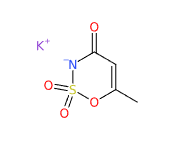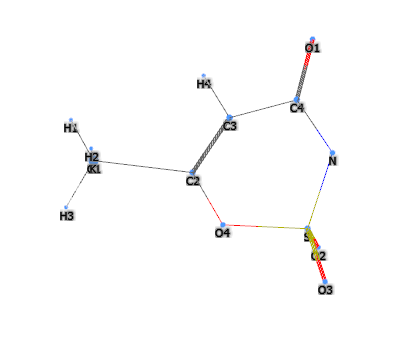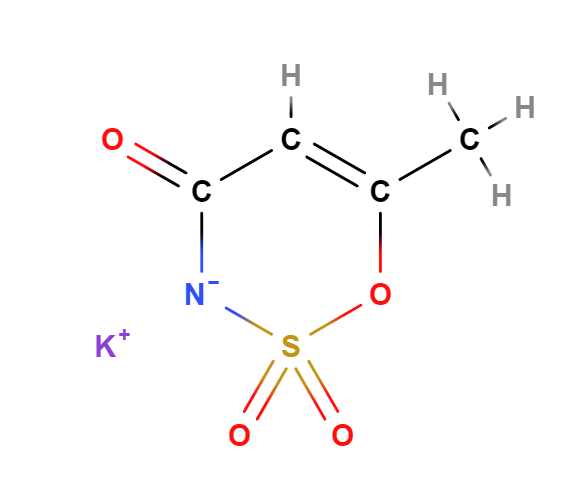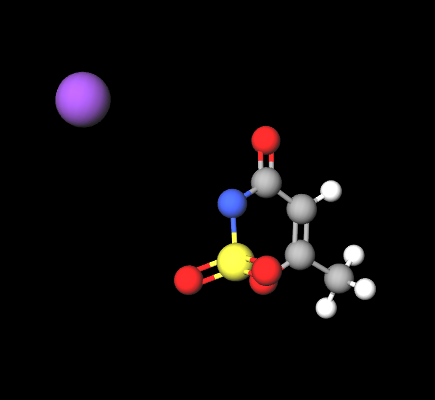![]() Acesulfame potassium
Acesulfame potassium
Rating : 5
| Evaluation | N. Experts | Evaluation | N. Experts |
|---|---|---|---|
| 1 | 6 | ||
| 2 | 7 | ||
| 3 | 8 | ||
| 4 | 9 | ||
| 5 | 10 |
Cons:
Avoid excessive amounts (1)10 pts from A_Partyns
| Sign up to vote this object, vote his reviews and to contribute to Tiiips.Evaluate | Where is this found? |
| "Acesulfame K studies" about Acesulfame potassium Review Consensus 8 by A_Partyns (12948 pt) | 2022-Nov-14 08:06 |
| Read the full Tiiip | (Send your comment) |
Compendium of the most significant studies with reference to properties, intake, effects.
Solomi L, Rees GA, Redfern KM. The acute effects of the non-nutritive sweeteners aspartame and acesulfame-K in UK diet cola on glycaemic response. Int J Food Sci Nutr. 2019 Nov;70(7):894-900. doi: 10.1080/09637486.2019.1585418.
Abstract. Substituting sugar-sweetened for artificially sweetened beverages may reduce energy intakes. This study aims to ascertain the acute glycaemic effects of the NNS aspartame and acesulfame-K in UK diet-cola (DC). Ten healthy participants attended the laboratory fasted on three occasions. Individuals drank (1) 25 g glucose in 125 mL water + 236 mL water, (2) 25 g glucose in 125 mL water with 236 mL DC and (3) 236 mL sucrose-sweetened cola with 125 mL water. Blood (glucose) was measured pre-test and every 15 minutes over a 120-minute period using portable glucometers. The glucose-control and glucose + DC elicited similar blood glucose rises above pre-prandial levels. Sucrose-sweetened cola showed a non-significant lower rise in postprandial glycaemia, exhibiting the lowest glycaemic index (GI) (77.0 ± 9.1). GI of glucose (100.0 ± 15.2) and glucose + DC (104.3 ± 8.5) was similar and a one-way repeated-measures ANOVA showed no significant differences in glycaemic response between test drinks (F(2,29) = 1.68, p > .05). Results demonstrate the glycaemic inactivity of non-nutritive sweeteners.
Tsan L, Chometton S, Hayes AM, Klug ME, Zuo Y, Sun S, Bridi L, Lan R, Fodor AA, Noble EE, Yang X, Kanoski SE, Schier LA. Early-life low-calorie sweetener consumption disrupts glucose regulation, sugar-motivated behavior, and memory function in rats. JCI Insight. 2022 Oct 24;7(20):e157714. doi: 10.1172/jci.insight.157714.
Abstract. Low-calorie sweetener (LCS) consumption in children has increased dramatically due to its widespread presence in the food environment and efforts to mitigate obesity through sugar replacement. However, mechanistic studies on the long-term impact of early-life LCS consumption on cognitive function and physiological processes are lacking. Here, we developed a rodent model to evaluate the effects of daily LCS consumption (acesulfame potassium, saccharin, or stevia) during adolescence on adult metabolic, behavioral, gut microbiome, and brain transcriptomic outcomes. Results reveal that habitual early-life LCS consumption impacts normal postoral glucose handling and impairs hippocampal-dependent memory in the absence of weight gain. Furthermore, adolescent LCS consumption yielded long-term reductions in lingual sweet taste receptor expression and brought about alterations in sugar-motivated appetitive and consummatory responses. While early-life LCS consumption did not produce robust changes in the gut microbiome, brain region–specific RNA-Seq analyses reveal LCS-induced changes in collagen- and synaptic signaling–related gene pathways in the hippocampus and nucleus accumbens, respectively, in a sex-dependent manner. Collectively, these results reveal that habitual early-life LCS consumption has long-lasting implications for glucoregulation, sugar-motivated behavior, and hippocampal-dependent memory in rats, which may be based in part on changes in nutrient transporter, sweet taste receptor, and central gene pathway expression.
Zopun M, Liszt KI, Stoeger V, Behrens M, Redel U, Ley JP, Hans J, Somoza V. Human Sweet Receptor T1R3 is Functional in Human Gastric Parietal Tumor Cells (HGT-1) and Modulates Cyclamate and Acesulfame K-Induced Mechanisms of Gastric Acid Secretion. J Agric Food Chem. 2018 May 16;66(19):4842-4852. doi: 10.1021/acs.jafc.8b00658.
Abstract. The noncaloric sweeteners (NCSs) cyclamate (Cycl) and acesulfame K (AceK) are widely added to foods and beverages. Little is known about their impact on gastric acid secretion (GAS), which is stimulated by dietary protein and bitter-tasting compounds. Since Cycl and AceK have a bitter off taste in addition to their sweet taste, we hypothesized they modulate mechanisms of GAS in human gastric parietal cells (HGT-1). HGT-1 cells were exposed to sweet tastants (50 mM of glucose, d-threonine, Cycl, or AceK) and analyzed for their intracellular pH index (IPX), as an indicator of proton secretion by means of a pH-sensitive dye, and for mRNA levels of GAS-associated genes by RT-qPCR. Since the NCSs act via the sweet taste-sensing receptor T1R2/T1R3, mRNA expression of the corresponding genes was analyzed in addition to immunocytochemical localization of the T1R2 and T1R3 receptor proteins. Exposure of HGT-1 cells to AceK or d-threonine increased the IPX to 0.60 ± 0.05 and 0.80 ± 0.04 ( P ≤ 0.05), respectively, thereby indicating a reduced secretion of protons, whereas Cycl demonstrated the opposite effect with IPX values of -0.69 ± 0.08 ( P ≤ 0.05) compared to controls (IPX = 0). Cotreatment with the T1R3-inhibitor lactisole as well as a TAS1R3 siRNA knock-down approach reduced the impact of Cycl, AceK, and d-thr on proton release ( P ≤ 0.05), whereas cotreatment with 10 mM glucose enhanced the NCS-induced effect ( P ≤ 0.05). Overall, we demonstrated Cycl and AceK as modulators of proton secretion in HGT-1 cells and identified T1R3 as a key element in this response.
Doummar J, Aoun M. Assessment of the origin and transport of four selected emerging micropollutants sucralose, Acesulfame-K, gemfibrozil, and iohexol in a karst spring during a multi-event spring response. J Contam Hydrol. 2018 Aug;215:11-20. doi: 10.1016/j.jconhyd.2018.06.003.
Abstract. The assessment of vulnerability in karst systems reveals to be extremely challenging since it varies significantly with time and highly depends on the identification of diffuse and concentrated infiltration from surface karst features. The origin, consumed loads, and transport mode of selected micropollutants (MPs) including two artificial sweeteners (ASWs) Sucralose (SUC) and Acesulfame-K (ACE-K), in addition to other less investigated pharmaceuticals such as the lipid regulator Gemfibrozil (GEM), and the contrast media Iohexol (IOX) were investigated in a karst system under dynamic conditions. A detailed analysis of selected spring responses' chemograph and hydrograph following a multi precipitation event shows that three of the tracked MPs, especially ACE-K, and to the exception of IOX, can be used as specific indicators for point source domestic wastewater in karst systems. They have revealed to be persistent, source specific, conservative, and highly correlated with in-situ parameters easily measurable at the spring (chloride and turbidity). Even if the selected MPs are found in the system during low flow periods, they are mostly transported to the spring through fast flow pathways from flushed wastewater with surface water or flood rainwater. The highest mass inflow of ACE-K, IOX and GEM originated from a sinking stream, while SUC infiltrated exclusively through fast infiltration points (dolines). Their breakthrough curves coincide with the arrival of new waters and turbidity peaks. Unlike IOX, the mass fluxes of ASWs, and GEM to a lesser extent, can be linearly correlated with chloride mass fluxes and turbidity flux. Moreover, the variance of the normalized breakthrough curves of the MPs with respect to a mean transit time, increases in that order IOXCopyright © 2018 Elsevier B.V.

Murray AB, Lomelino CL, Supuran CT, McKenna R. "Seriously Sweet": Acesulfame K Exhibits Selective Inhibition Using Alternative Binding Modes in Carbonic Anhydrase Isoforms. J Med Chem. 2018 Feb 8;61(3):1176-1181. doi: 10.1021/acs.jmedchem.7b01470.
Abstract. Human carbonic anhydrase IX (CA IX) is upregulated in neoplastic tissues; as such, it is studied as a drug target for anticancer chemotherapy. Inhibition of CA IX has been shown to be therapeutically favorable in terms of reducing tumor growth. Previously, saccharin, a commonly used artificial sweetener, has been observed to selectively inhibit CA IX over other CA isoforms. In this study, X-ray crystallography showed acesulfame potassium (Ace K) binding directly to the catalytic zinc in CA IX (mimic) and through a bridging water in CA II. This modulation in binding is reflected in the binding constants, with Ace K inhibiting CA IX but not other CA isoforms. Hence, this study establishes the potential of Ace K (an FDA approved food additive) as a lead compound in the design and development of CA IX specific inhibitors.

Liu Y, Blowes DW, Groza L, Sabourin MJ, Ptacek CJ. Acesulfame-K and pharmaceuticals as co-tracers of municipal wastewater in a receiving river. Environ Sci Process Impacts. 2014 Dec;16(12):2789-95. doi: 10.1039/c4em00237g.
Abstract. Wastewater treatment plant (WWTP) effluents are important sources of emerging contaminants at environmentally-relevant concentrations. In this study, water samples were collected from a river downstream of two WWTPs to identify practical tracers for tracking wastewater. The results of the study indicate elevated concentrations of Cl(-), nutrients (NH3-N and NO2(-)), the artificial sweetener acesulfame-K (ACE-K), and the pharmaceuticals carbamazepine (CBZ), caffeine (CAF), sulfamethoxazole (SMX), ibuprofen (IBU), gemfibrozil (GEM), and naproxen (NAP) in the river close to the WWTPs that decreased with distance downstream. A correlation analysis using the Spearman Rank method showed that ACE-K, CBZ, GEM, NAP, and Cl(-) were strongly correlated with each other over a 31 km stretch of the river in the study area. The strong correlations of these target compounds indicate that the artificial sweetener ACE-K and the pharmaceuticals CBZ, GEM, and NAP can potentially be used as co-tracers to track wastewater.
Arora S, Shendurse AM, Sharma V, Wadhwa BK, Singh AK. Assessment of stability of binary sweetener blend (aspartame x acesulfame-K) during storage in whey lemon beverage. J Food Sci Technol. 2013 Aug;50(4):770-6. doi: 10.1007/s13197-011-0386-0.
Abstract. In the present study, artificial sweeteners-aspartame, acesulfame-K and binary sweetener blend of aspartame x acesulfame-K were assessed for stability during storage in whey lemon beverage. A solid phase extraction method using C18 cartridges was standardized for the isolation of aspartame, acesulfame-K and their degradation products in whey lemon beverage. HPLC analytical conditions were standardized over C18 column for simultaneous separation of multiple sweeteners and their degradation products in sample isolates. Storage studies revealed that increase in acidity and viscosity and decrease in pH and ascorbic acid content of artificially sweetened whey lemon beverage samples were similar to the changes occurring in control samples during storage. Analysis using HPLC showed that aspartame (added either singly or in a blend) and acesulfame-K (added in a blend) were stable in whey lemon beverage under refrigerated condition for 15 days.
Zhang GH, Chen ML, Liu SS, Zhan YH, Quan Y, Qin YM, Deng SP. Effects of mother's dietary exposure to acesulfame-K in Pregnancy or lactation on the adult offspring's sweet preference. Chem Senses. 2011 Nov;36(9):763-70. doi: 10.1093/chemse/bjr050.
Abstract. This study investigates whether mother's exposure to the artificial sweetener acesulfame-K (AK) during pregnancy or lactation affected her adult offspring's sweet preference. It was found that mother's dietary exposure to AK in pregnancy or lactation decreased the preference thresholds for AK and sucrose solutions in the adult offspring, whereas the preference pattern and the most preferred concentration for AK or sucrose solution were unchanged. Furthermore, the preference scores in the exposure groups were increased significantly when compared with the control group at a range of concentrations for AK or sucrose solution. The existence of AK and its dynamic changes within 24 h in amniotic fluid during pregnancy or in mother's milk during lactation after a single oral infusion of AK solution were revealed by the methods of reversed-phase high-performance liquid chromatography and mass spectrometry. Our data suggest that AK can be ingested by the prenatal or postnatal mice through their mother's amniotic fluid or breast milk, producing a long-dated function on the adult's sweet preference.
| Sign up to vote this object, vote his reviews and to contribute to Tiiips.EvaluateClose | (0 comments) |
| "Descrizione" about Acesulfame potassium Review Consensus 10 by A_Partyns (12948 pt) | 2022-Nov-14 09:11 |
| Read the full Tiiip | (Send your comment) |
Acesulfame potassium or Acesulfame K is a chemical compound, derived from sulphuric acid, the potassium salt of acesulfame (6-methyl-1,2,3-oxathiazine-4(3H)-one 2,2-dioxide), which belongs to the class of sulphonamides or sulfonamides of which it is an acid cyclic. Sulphonamides are chemically produced antibacterial drugs.
It appears as a white crystalline powder easily soluble in water, slightly soluble in ethanol.

What it is used for and where
Food
Acesulfame K is one of the most widely used low-calorie artificial sweeteners replacing sugar, about 200 times sweeter and belongs to the non-nutritive sweeteners (NNS). It is labelled with the number E950 in the list of European food additives as a sweetener.

High-intensity sweeteners are believed to be potential organic contaminants due to their widespread use in foods, drugs and healthcare products. They are introduced into the environment by different paths and are introduced into the waters (1).
The cause of the pollution is the extreme persistence resistant to water treatment processes for the continuous introduction in the aquatic environments, in particular for the Acesulfame present above all in winter (2).

Regarding human health, Acesulfame has been (2014) tested in concentrations equal to those found in non-alcoholic drinks, but, at least in this study, no interference has been found on the aryl receptor and on the glucocorticoid receptor. (3).
However, an ADI or Admissible Daily Dose of 15 mg/kg of body weight is provided. In this study, however, unlike Sucralose, another sweetener, Acesulfame K, at the maximum levels of DGA, did not influence the relative amount of Clostridium XIVa cluster in the metabolism of fecal microbes and cholesterol in laboratory animals (4) .
Pregnant and lactating women, children, diabetics and epilepsy patients represent the susceptible population to the adverse effects of Nonnutritive sweeteners (NNS) containing products and should use these products with utmost caution. The overall use of NNS remains controversial, and consumers should be amply informed about the potential risks of using them, based on current evidence-based dietary guidelines.
An 11–12 years follow-up study in the UK showed that consuming 2 or more servings of NNS-containing diet soft drinks increased the risk of coronary heart disease and chronic kidney disease in comparison with consuming.
Recent studies have suggested that this artificial sweetener may cause undesirable effects to the intestinal mucosa (6).
For more information:
Acesulfame potassium studies
Typical commercial product characteristics Acesulfame potassium
| Appearance | White crystalline solid |
| pH | 5.5-7.5 |
| Boiling Point | 332.7ºC at 760 mmHg |
| Melting Point | 229-232°C |
| Flash Point | 155ºC |
| Density | 1.512g/cm3 |
| LogP | 0.47680 |
| PSA | 68.82000 |
| Loss on Drying | ≤1% at 105°C |
| Ultraviolet Absorption | 227±2nm |
| Organic Impurities | ≤20 μg/g |
| Heavy Metals | ≤5 mg/kg |
| As | ≤3 mg/kg |
| Pb | ≤1 mg/kg |
| Selenium | ≤10 mg/kg |
| Fluoride | ≤3 mg/kg |
| Particle Size | 30-100 mesh |
| Storage | 0-6°C |
 |  |
 |  |
Price
1 kg $42
- Formula molecolare: C4H4KNO4S
- Peso molecolare: 201.237 g/mol
- CAS: 55589-62-3
- EC Number: 259-715-3
- UNII 23OV73Q5G9
- DSSTox Substance ID DTXSID1030606
- IUPAC potassium;6-methyl-2,2-dioxo-1-oxa-2λ6-thia-3-azanidacyclohex-5-en-4-one
- InChl=1S/C4H5NO4S.K/c1-3-2-4(6)5-10(7,8)9-3;/h2H,1H3,(H,5,6);/q;+1/p-1
- InChl Key WBZFUFAFFUEMEI-UHFFFAOYSA-M
- SMILES CC1=CC(=O)[N-]S(=O)(=O)O1.[K+]
- PubChem Substance ID 329747862
- MDL number MFCD00043833
- RTECS RP4489165
- ChEBI 184415
- Beilstein Registry Number 3637857
- NCI C76512
- RXCUI 1310545
Synonyms:
- Acesulfame potassium
- potassium 6-methyl-4-oxo-4H-1,2,3-oxathiazin-3-ide 2,2-dioxide
- 6-Methyl-1,2,3-oxathiazin-4(3H)-one 2,2-dioxide potassium salt
- Acesulfame-potassium
- Acesulfame-K
- Potassium 6-methyl-1,2,3-oxathiazin-4(3H)-one 2,2-dioxide
- Potassium 6-methyl-2,2-dioxo-1-oxa-2$l^{6}-thia-3-azanidacyclohex-5-en-4-one
- Sunnett
- Otizon
- Sunett
- Sweet One.
- E 950
- 6-methyl-3H-1,2,3-oxathiazine-2,2,4-trione, potassium salt
- Acesulfame potassium, European Pharmacopoeia (EP) Reference Standard
- 6-Methyl-3,4-dihydro-1,2,3-oxathiazin-4-one 2,2-Dioxide Potassium Salt
- potassium;6-methyl-2,2-dioxo-1-oxa-2?^{6}-thia-3-azanidacyclohex-5-en-4-one
References____________________________________________________________________
(1) Arbeláez P, Borrull F, Pocurull E, Marcé RM. Determination of high-intensity sweeteners in river water and wastewater by solid-phase extraction and liquid chromatography-tandem mass spectrometry. J Chromatogr A. 2015 May 8;1393:106-14. doi: 10.1016/j.chroma.2015.03.035.
(2) Sang Z, Jiang Y, Tsoi YK, Leung KS. Evaluating the environmental impact of artificial sweeteners: a study of their distributions, photodegradation and toxicities. Water Res. 2014 Apr 1;52:260-74. doi: 10.1016/j.watres.2013.11.002.
(3) Kamenickova A, Pecova M, Bachleda P, Dvorak Z. Effects of artificial sweeteners on the AhR- and GR-dependent CYP1A1 expression in primary human hepatocytes and human cancer cells.
Toxicol In Vitro. 2013 Dec.
(4) Uebanso T, Ohnishi A, Kitayama R, Yoshimoto A, Nakahashi M, Shimohata T, Mawatari K, Takahashi A. Effects of Low-Dose Non-Caloric Sweetener Consumption on Gut Microbiota in Mice. Nutrients. 2017 Jun 1;9(6):560. doi: 10.3390/nu9060560.
(5) Sharma A, Amarnath S, Thulasimani M, Ramaswamy S. Artificial sweeteners as a sugar substitute: Are they really safe? Indian J Pharmacol. 2016 May-Jun;48(3):237-40. doi: 10.4103/0253-7613.182888.
Gardner C, Wylie-Rosett J, Gidding SS, Steffen LM, Johnson RK, Reader D, Lichtenstein AH; American Heart Association Nutrition Committee of the Council on Nutrition, Physical Activity and Metabolism, Council on Arteriosclerosis, Thrombosis and Vascular Biology, Council on Cardiovascular Disease in the Young, and the American D. Nonnutritive sweeteners: current use and health perspectives: a scientific statement from the American Heart Association and the American Diabetes Association. Circulation. 2012 Jul 24;126(4):509-19. doi: 10.1161/CIR.0b013e31825c42ee.
(6) Hanawa Y, Higashiyama M, Kurihara C, Tanemoto R, Ito S, Mizoguchi A, Nishii S, Wada A, Inaba K, Sugihara N, Horiuchi K, Okada Y, Narimatsu K, Komoto S, Tomita K, Hokari R. Acesulfame potassium induces dysbiosis and intestinal injury with enhanced lymphocyte migration to intestinal mucosa. J Gastroenterol Hepatol. 2021 Nov;36(11):3140-3148. doi: 10.1111/jgh.15654.
| Sign up to vote this object, vote his reviews and to contribute to Tiiips.EvaluateClose | (0 comments) |
Read other Tiiips about this object in __Italiano (2)
Component type: Chemical Main substances: Last update: 2022-11-14 07:41:57 | Chemical Risk: |


